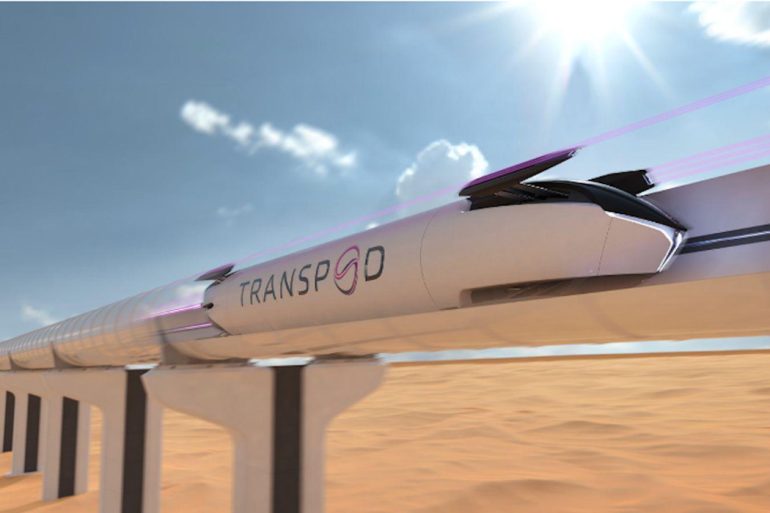TransPod has pulled back the curtain on the transportation tech it has spent the last five years developing, researching, and testing.
At an event held yesterday at the MaRS Discovery District, the Toronto-based AutoTech startup showcased a nearly one-tonne, quarter-scale model of the FluxJet, which TransPod co-founder and CTO Ryan Janzen described as “a new category” of vehicle.
“The FluxJet is different from an aircraft and it’s different from a train,” said Janzen. “It’s a whole new type of vehicle.”
“The FluxJet is different from aircraft and it’s different from a train. It’s a whole new type of vehicle.”
-Ryan Janzen, TransPod co-founder and CTO
The FluxJet is a fully-electric vehicle designed to carry people and goods in a low-pressure, sealed tube environment at speeds that exceed 1,000 kilometres per hour—which TransPod says would make it “faster than a jet and three times as fast as a high-speed train.”
With the FluxJet, TransPod hopes to disrupt passenger and cargo transportation by offering a new, fast, affordable, and more environmentally-friendly means of travel between cities.
Backed by Italy’s Angelo Investments, TransPod will deploy its FluxJet vehicles in its proposed “ultra-high-speed” transportation system connecting Calgary and Edmonton. The startup shared Thursday that it has already begun preliminary construction work on the $18 billion USD initiative, including an environmental impact assessment.
While the project has faced some roadblocks from the Government of Alberta, TransPod co-founder and CEO Sebastien Gendron told BetaKit that the startup has begun to overcome them.
“All the hard work over the past few years has led to this milestone moment where talk is becoming a reality,” said Gendron.
In a presentation, Janzen outlined some of the science and technological advances that underpin the FluxJet, which brings together three different types of flux: veillance flux, magnetic flux, and electric flux. On the latter front, the FluxJet uses plasma to access power without touch.
According to the CTO, this enables the FluxJet to travel at faster speeds than traditional and electric trains. “Friction is the enemy of speed,” he said. “So everything about the FluxJet is designed to avoid friction.”
The FluxJet is an automated, sensor-laden, computer vision-enabled electric vehicle with no windows or pilots, eight engines, and 11 computers. Janzen highlighted some of the FluxJet’s capabilities during a live demonstration, showcasing the FluxJet’s ability to levitate within the tube, while an assistant rocked the otherwise immovable device back and forth.
Gendron noted that TransPod’s FluxJet line is not intended to replace aircrafts, trains, or cars, adding that the company’s views its solution as a good complement to existing modes of transportation. “This system will provide the frequency of the subway with the speed of the aircraft,” he said.
Hyperloops are proposed modes of transportation that involve a sealed tube with low air pressure through which a pod can travel free of air resistance or friction. Tesla co-founder CEO Elon Musk first publicly discussed Hyperloop in 2012, sharing an early concept involving reduced-pressure tubes in which pressurized capsules ride on air bearings driven by a system of motors and compressors.
While Hyperloop systems have been criticized as absurdly expensive, that hasn’t prevented companies like Virgin Hyperloop from working on developing them.
But TransPod has argued that its system differs from Hyperloop systems. “We’re trying to move away from that word [Hyperloop] just to really differentiate ourselves from what the public thinks,” said Gendron. “This is not Elon Musk’s technology; it’s a transportation technology.”
RELATED: TransPod signs deal with Alberta to develop Hyperloop track connecting Edmonton, Calgary
BetaKit reported earlier this year that TransPod was awaiting consent from the Government of Alberta to secure nearly $700 million CAD in financing from United Kingdom-based Broughton Capital Group to support the development of a new high-speed transportation system in the province.
Speaking with BetaKit yesterday, Gendron said Alberta has since outlined plans to modify its Railway Act later this year to integrate TransPod, and ensure it has the access it needs to the Expropriation Act in order to construct the line.
Gendron added that he doesn’t expect recent political turnover among the Government of Alberta’s leadership to have an impact on the project, noting that TransPod continues to work with the same group of people at the province that it has been dealing with for years.
While connecting Calgary and Edmonton is the main focus for TransPod right now, Gendron mentioned that down the line, TransPod also sees potential in rolling out a new form of high-speed travel to connect Toronto with Montréal.
Feature image courtesy TransPod.


